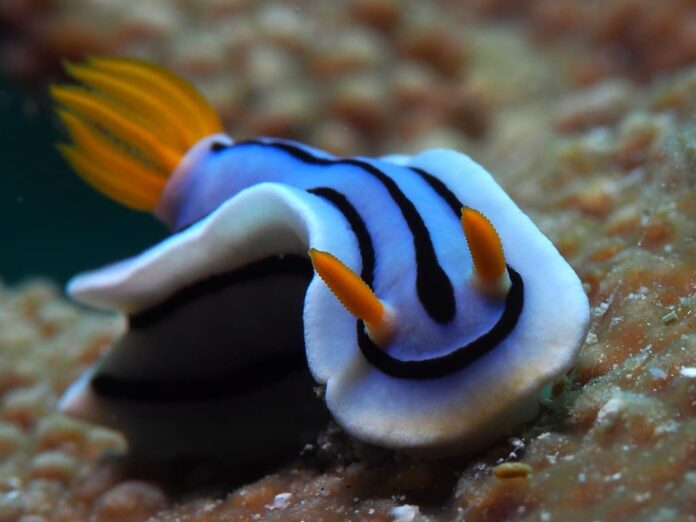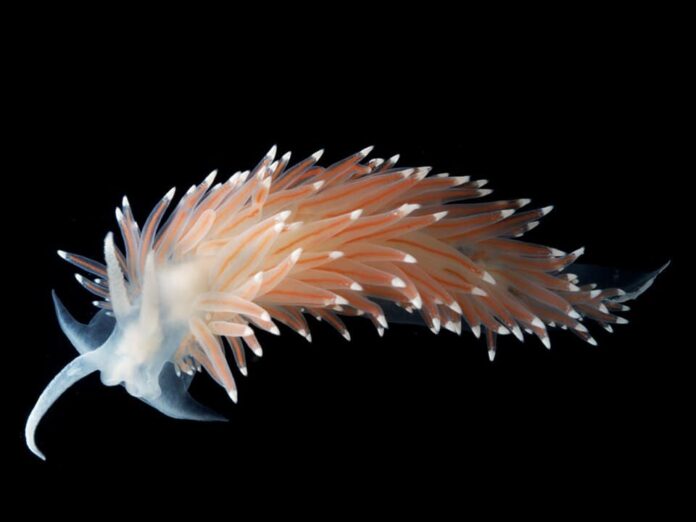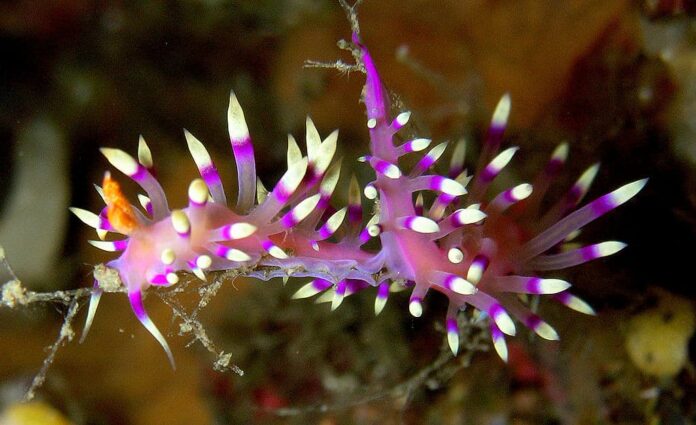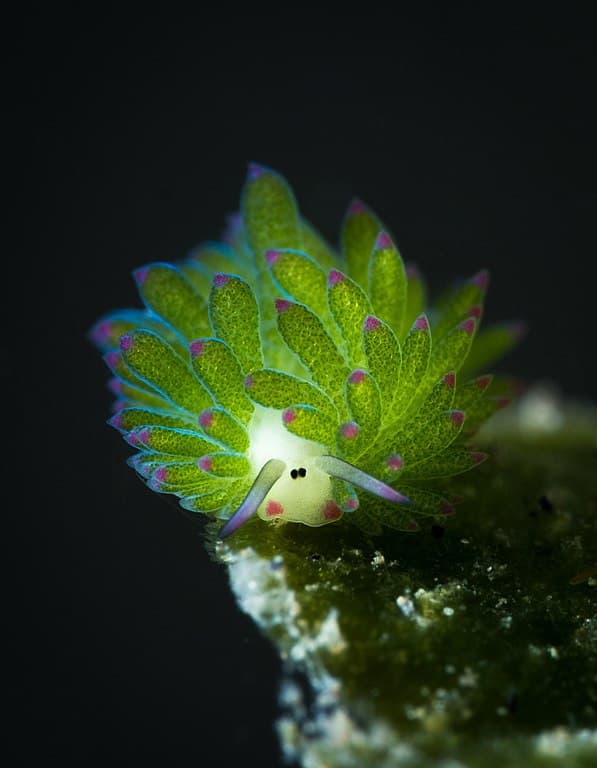Sea slugs are the perfect example of colorful creatures whose beauty should be admired from the distance. Why? Some colorful sea slugs are toxic, and the most colorful ones are tempting types to us. However, we will only focus on the colorful sea slugs today because they are so gorgeous. I also include some brief and interesting information about those sea slugs for you as well. You will find 10 of them in the list below, let me know which one you think is the most beautiful.
1Blue Angel

Looking like a mythical creature, this colorful sea slug also goes by other names like a blue dragon or blue glaucus. You can find them in temperate and tropical waters throughout the Atlantic, Indian, and Pacific Oceans. It is a species of nudibranch sea slug, the one with beautiful and bright colors. This is a great method that provides the sea slug itself with camouflage ability and an effective defense mechanism against predation. Blue angel is a small sea slug species that rarely reaches over 3 centimeters (1.2 inches) long. Despite its small body, it often preys on larger animals, preferably the ones with stinging cells that benefit it later. A blue angel is not born venomous, it got its toxic chemicals or stinging cells from its prey into its own skin.
If it eats a Portuguese man o’war, it stores the stinging nematocysts from that jellyfish for future use. Next time it is touched or threatened, it will release those stinging cells to deliver an even more potent sting. Blue angel form groups are known as “blue fleets” where they feed together or when mating season comes. Sometimes they will curl into balls to protect themselves when they are caught in waves. This is also how people saw a bunch of them on the beach or nearby the shore. The thing to bare in mind is that blue angels are still venomous even if they are stranded on land or after they die. So if humans pick them up or step on them, they might experience the sting from this little sea slug.
2Cadlinella Ornatissima

Here we have a colorful sea slug species that consist of a bright yellow to orange body. The thing is that you cannot confuse this species with any other due to its unique features. You can easily recognize them by the large elongated pink-tipped tubercles on their dorsum. Plus with many white thick elongated warts with reddish or pink tips, spotting one is a piece of cake. These sea slugs live in the tropical waters of the Indo-West Pacific ocean where they feed on a number of sponges. Apart from sponges, these sea slugs also eat barnacles, sea squirts, and soft corals that they can find. This species is still under study, so we don’t know whether it is dangerous or toxic to consume.
3Chromodoris Lochi

This sea slug species goes by the common name of Loch’s Chromodoris, and it is one of the colorful sea slugs. It has a blue or blueish-wgite body with a white margin and 3 black or dark lines running down the mantle. The lines also run around the border passing on the outside of the rhinophore of the sea slug as well. Another characteristic feature of these sea slugs is the plain colored gills with translucent straw color to dull orange or pink. Just like many other sea slugs from the same family, this one also feeds exclusively on sponges. You can find them in the tropical waters of the central Indo-Pacific region, ranging from Southeast Asia to northern Australia.
4Dirona Albolineata

This is a sea slug species with a broad and large translucent body along with flat cerata. The color of these sea slugs ranges from lavender and pale orange to rose pink and rufous shades. Another special thing about them is the distinctive bright white lines along the edges that add amazing details. No matter what color they are, they always look absolutely phenomenal which is very beautiful. This one can grow up to 17.5 centimeters (6.8 inches) long although the common size is around 5 centimeters (1.9 inches). Dirona Albolineata lives in shallow subtidal cold waters of the Eastern and Western Pacific Oceans, ranging from North America to Japan. They generally reside on rocks but you can also find them in mud in the intertidal or docks and pilings. In their habitats, they feed on ascidians, bryozoans, hydroids, small crustaceans, and snails.
5Hypselodoris Kanga

As for this sea slug species, it looks as if it comes from a drawing by an artist. A sea slug from this species has a blue-gray body that is covered in black and yellow spots. Along with that, there are also black spots and blue coloration at the edge of its mantle as well. Meanwhile, its rhinophores are red and the rhinophore stalks are deep blue in color. This one is found throughout the Indian Ocean and West Pacific Ocean as well as in Dar es Salaam, Kunduchi, and Tanzania. They live on coral rubble and rocky shores with encrusting animals and sponges that they can feed on.
6Leaf-Gilled Sea Slug

You are looking at the icon of the Great Barrier Reef with its photos all over brochures and posters. This sea slug species represents not only the beauty but also the undersea curiosities at the same time. Being one of the most beautiful and colorful sea slugs, they have this unique leaf-like feature that makes them stand out. The thing is that these projections on their bodies are not just for show, they are parts of defense mechanisms. Those leaves are toxic, and they can drop off and wiggle on their own to distract the predators. This is how these sea sheep escape to a safer place and regrow their armor back again. Leaf-gilled sea slugs are widespread throughout the Indo-Pacific ocean, and they feed on algae.
7Leaf Sheep Sea Slug

When it comes to beauty, leaf sheep sea slugs totally slay. We can all agree that this is one of the most beautiful, colorful, and unique sea slugs. Leaf sheep sea slugs look like adorable cartoon characters whose beauty is too good to be true. They are so small, but their physical appearance has every detail to make them look extraordinary. As you can see, their eyes are 2 black dots that somehow displays a timid expression on their faces. These tiny gastropods have leaf-like cereta with green color popping out of their body surfaces. On its head are rhinophores that resemble a sheep’s ears; hence the name. Those rhinophores have fine hairs that help the sea slug sense chemicals in the water to find food sources.
The awesome thing about them is that these sea slugs are among the few sea creatures that can photosynthesize. Their primary diet is algae, and they can suck the chloroplasts out of the algae during consumption. This process enables them to photosynthesize which causes them to glow with the bioluminescent look. If you are lucky, you might find them on reefs off the coasts in Japan, Indonesia, and the Philippines. Although not in critical danger yet, these sea slugs are facing threats to their survival which are destructive fishing and habitat loss. Fishermen use cyanide or dynamite which destroys marine habitats while killing animals living in them. Climate change and pollution also play important parts in their population decline, especially in the Philippines.
8Nobilis Aeolis

Nobilis aeolis or borealea nobilis is another colorful sea slug species that many people find adorable. A nobilis aeolis has a translucent white body with opaque white markings. Its rhinophores are pale yellow-brown and covered with small papillae. The interesting is that this species also comes in different colors. Some have a light brown body and red rhinophores with white tips. No matter what color, these sea slugs always appear to be on a good hair day every day. The population of this sea slug is widespread in the northern Atlantic Ocean, the North American coast, and southern New England.
9Sea Bunny

Sea bunny is one of the most adorable sea slugs whose name tells exactly what it resembles. A sea bunny has two rhinophores on its head that look like a rabbit’s ears. On its body are fleshy papillae with black knobs that give the sea bunny its speckled appearance. The papillae are used for sensory functions while the rhinophores are the sensory organs that work for the act of chemoreception. This allows them to avoid predators, locate mates, and sense the surrounding environment when foraging for food resources. Sea bunnies feed on sponges that contain toxins that make them very toxic to consume. They inhabit the coasts of Australia, Indonesia, Japan, Korea, Palau, Papua New Guinea, the Philippines, South Africa, Seychelles, and Tanzania. The lifespan of sea bunnies is very short since they live for just a few months to a year.
10Violet Sea Slug

With striking purple color, violet sea slugs are clearly one of the most adorable and colorful sea slugs to see. A violet sea slug has a pink-purple or violet body with white tips to the projections running along its back. There are 2 antennae on its head and 2 more on each side of its mouth that detect food. These sea slugs live on the hydroids and moderately exposed rocky sublittoral areas which are where they feed. You can find them on all British coasts, and they are most common in summer from April to October. This species also live in the Atlantic Ocean, the Mediterranean, and far north in Norway.
Bonus: Cabbage Patch Sea Slug

The cabbage patch sea slug or Nembrotha Cristata is another colorful slug species with a super cute look. At a glance, it is like a mini dinosaur with small wings on its back. These sea slugs have black bodies with green markings along with raised green nodules. There are 2 rhinophores that look like horns on their heads, and those are their smelling organs. Just like most sea slugs out there, this cute little thing is also toxic because it feeds on compound tunicates and jellyfish. Cabbage patch sea slugs live on coral reefs and rocks in the tropical Indo-West Pacific Ocean.
Related Post: Sea Creatures That Look Like They Are From Sci-Fi Movies




